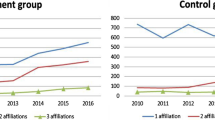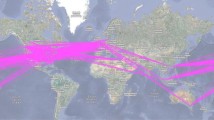Abstract
A new quantitative method is introduced to analyze the collaboration among different organizations. The method defines the collaboration score based on the number of people involved in collaboration, and then the collaboration strength is obtained by summing up the collaboration scores with this method. We choose “Project 985” universities, which represent the top universities in China, as an example to study the collaboration network, strength in leading collaboration and strength in participating collaboration. Results based on Scopus show some characteristics of such collaboration and verify the feasibility of the new approach.




Similar content being viewed by others
Reference
Adams, J. (2012). Collaborations: the rise of research networks. Nature, 490, 335–336.
Bordons, M., Gomez, I., Fernandez, M. T., Zulueta, M. A., & Mendez, A. (1996). Local, domestic and international scientific collaboration in biomedical research. Scientometrics, 37(2), 279–295.
Fu, H. Z., Chuang, K. Y., Wang, M. H., & Ho, Y. S. (2011). Characteristics of research in China assessed with essential science indicators. Scientometrics, 88(3), 841–862.
Hu, X. J. (2009). Loads of special authorship functions: Linear growth in the percentage of “equal first authors” and corresponding authors. Journal of the American Society for Information Science and Technology, 60(11), 2378–2381.
Institute of scientific and technical information of China. (2012). Statistical data of Chinese S&T papers. Beijing: Institute of scientific and technical information of China.
Jarneving, B. (2010). Regional research and foreign collaboration. Scientometrics, 83(1), 295–320.
Luukkonen, T., Tijssen, R. J. W., Persson, O., & Sivertsen, G. (1993). The measurement of international scientific collaboration. Scientometrics, 28(1), 15–36.
Newman, M. E. J. (2001a). The structure of scientific collaboration networks. PNAS, 98(2), 404–409.
Newman, M. E. J. (2001b). Scientific collaboration networks I Network construction and fundamental results. Physical review E, 64, 016131.
Newman, M. E. J. (2001c). Scientific collaboration networks. II. Shortest paths, weighted networks, and centrality. Physical Review E, 64, 016132.
Newman, M. E. J. (2004). Coauthorship networks and patterns of scientific collaboration. PNAS, 101(s1), 5200–5205.
Qiu, J. P., & Ma, F. (2011). A study on the relationships between citation and collaboration (pp. 693–699). Durban: Proceedings of the ISSI.
Wang, X., Xu, S., Wang, Z., Peng L., Wang C. (2012). International scientific collaboration of China: collaborating countries, institutions and individuals. Scientometrics, doi: 10.1007/s11192-012-0877-4.
Zhang, H., Patton, D., & Kenney, M. (2013). Building global-class universities: assessing the impact of the 985 Project. Research Policy, 42(3), 765–775.
Acknowledgments
The study was supported by the project of “National Natural Science Foundation of China” (70973118). The authors wish to thank anonymous reviewers who gave valuable suggestion that has helped to improve the quality of the manuscript.
Author information
Authors and Affiliations
Corresponding author
Rights and permissions
About this article
Cite this article
Wang, W., Wu, Y. & Pan, Y. An investigation of collaborations between top Chinese universities: a new quantitative approach. Scientometrics 98, 1535–1545 (2014). https://doi.org/10.1007/s11192-013-1072-y
Received:
Published:
Issue Date:
DOI: https://doi.org/10.1007/s11192-013-1072-y




